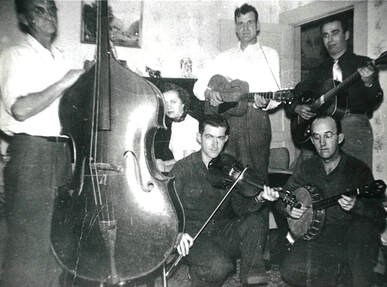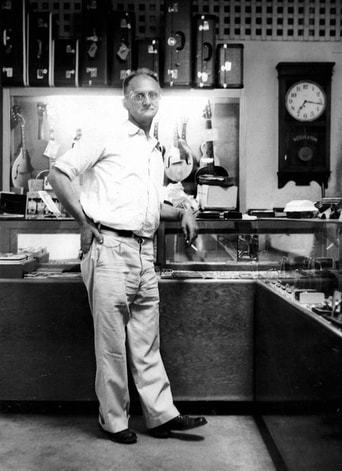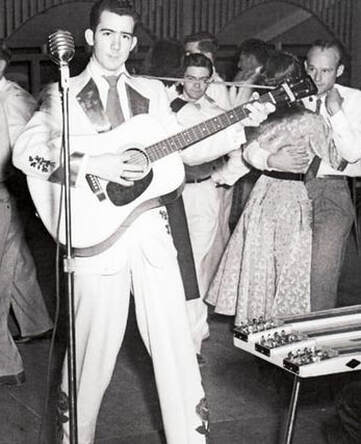The Latta Ramblers
House Band for the Latta Motor Jams and the Stanton Littlejohn Sessions

As read by Christy Sills, Arts in McNairy Board President
June 13, 2020
A whole new generation of McNairy County youth is familiar with the name Latta. When they hear the name, they are most likely to associate it with the property situated at the corner of West Court Avenue and North 4th Street in downtown Selmer. More precisely, they are likely to think of the cultural experiences they enjoyed at what is now affectionately referred to as “The Latta.” They say things like, “I saw an incredible band at the Latta last weekend.”
What they may not know is that the name Latta, and those words, “I saw an incredible band at the Latta last weekend,” could just as easily have been spoken in their grandparents and great-grandparents generations. Most of them probably don’t realize that more than 70 years ago the name Latta identified a prominent local family, the same property at 205 West Court Avenue, and an outstanding band, all at once.
To be fair to the younger generation, many of their elders may know the story of Earl Latta’s successful Ford dealership in downtown Selmer, and may even have heard that he hosted music events on the property, but the band that is most responsible for the success of those shows has not yet been fully acknowledged or appreciated.
That band was called the Latta Ramblers, and this is their story.
Earl Latta was an amateur musician and devoted music fan, but he was first and foremost a savvy business man. As it turns out, he was an early industry leader in what is now known as “retail-tainment.” He knew that one of the best ways to get the attention of customers was to offer quality entrainment that would draw the public into his place of business and create positive associations with his products. In midcentury McNairy County, that could only mean one thing: live music. For that, he turned to group of musicians who styled themselves the Latta Ramblers in order to further accentuate the connection between Latta’s business and the free music it offered potential buyers. But make no mistake, the Latta Ramblers were not cheap salespeople, or cheesy jingle writers—not even close. They were, in fact, one of the best assemblages of musical talent McNairy County had to offer in the 1940s and 50s.
From the very beginning, Tom McCormack, Paul Taylor, Eunice Smith, and Rob Richards were the core members of the Latta Ramblers. Other players came and went, and the band was well known to have top notch instrumentalists or vocalists sit in for a set or two at the Latta jamborees, but these four—each gifted musician in their own right—were the heart and soul of the Latta Ramblers.
Tom McCormack, like his father Granville McCormack before him, was a mechanic for Latta Motors. That gave him the inside track on Earl Latta’s weekend music jamborees and McCormack was instrumental in handling the logistical aspects of those shows. In a matter of hours, he was responsible for converting the dealership’s auto service area into a performance hall to accommodate sometimes dozens of musicians, and almost always hundreds of audience members. Of course, by Monday morning it had to be a functional garage space again, and he oversaw that too. But McCormack was far more than a stage manager. He was a talented guitarist and founding member of the Latta Ramblers who used his musical contacts to help book other acts for the jamborees and coordinate the shows’ lineups. After the untimely death of Latta Ramblers member, Rob Richards, McCormack sought to fill the void left by the loss one of the area’s most respected bassists. In a demonstration of his versatility as both mechanic and musician, he retrofitted an old Silvertone guitar as an electric bass and joined the Chickasaw Ramblers—Hall of Famer, Pap Whitten’s, legendary dance band. For almost a quarter century that version of the Chickasaw Ramblers became the best loved dance band in the region, anchoring square dances at Finger, Leapwood and Chewalla in McNairy County; Five Points in Madison County, and the Hardin County Fairgrounds in Savannah.
Eunice Littlejohn Smith, the sister of Hall of Famer, Stanton Littlejohn, was already a veteran of the regional music scene when she joined the Latta Ramblers on accordion. The exceptionally gifted Smith had adapted her own original accordion style to accompany old-time string band music to great effect. She could play it like a rhythm instrument or double the fiddle lead, note for note. Smith had honed those skills as a young woman playing radio broadcasts with Waldo Davis and the Midnight Ramblers, as well as several other popular bands in the region. She was also in demand, virtually all of her adult life, as one of region’s best pianists. Many of her brother Stanton’s audio recordings from the late 1940s and early 50s reveal that Smith was a musician with astonishing range and an ability to play nearly any genre of music on demand. Some years later, she would join fellow Latta Ramblers member, Tom McCormack, in Pap Whitten’s Chickasaw Ramblers where the piano technique she adapted for square dance music was as original and influential as her accordion style.
Paul Taylor, the Latta Ramblers second guitarist, was, like McCormack, employed by Latta Motors, managing the tractor and implement division. In that role, he worked with McCormack to set up and tear down for the garage jamborees and oversee the administration of the shows. And like Smith, Taylor had cut his teeth as a performer working on road and radio gigs with Waldo Davis. Taylor’s life and amateur musical career were tragically cut short by and automobile accident in 1957, but not before he left his mark on his family, friends, and the audiences who revered his outstanding musical abilities.
Finally, Rob Richards was the bassists for the Latta Ramblers, and what a bassist he was. Richards played with virtually every important musician in Southwest Tennessee and north Mississippi over the course of an impressive 35 years in music. Appropriately, Richards is being inducted to the Hall of Fame this year as an individual artist, so we can refer you to his induction remarks for a fuller accounting of his contributions, but suffice it to say, more than 50 years after his passing, he is still regarded as McNairy County’s preeminent bass fiddle player.
Tedford Jordan sometimes joined the Latta Ramblers on banjo. Evelyn Seay regularly added her accordion skills to the mix, or sat in for Eunice Smith. James Lambert and Hall of Famer, Arnold English, often played fiddle for the Ramblers and Curtis White was another known collaborator. But the core group was always, McCormack, Smith, Taylor and Richards.
With the exception of Earl Latta himself, the Latta Ramblers were more responsible than anyone for the storied Latta Ford Motor Company jamborees. They were the manpower and musical foundation for those shows. Quite simply, without them there would have been no show. They set a pattern for community music making and their monumental achievements reverberate even now in two generations of local and regional musicians they influenced.
Maybe just as importantly, the Latta Ramblers doubled as a sessions band for the Stanton Littlejohn recordings. Their close association with Littlejohn put them in a position to play in support of some of the region’s acknowledged masters. The Latta Ramblers can be heard on a number of Littlejohn’s best sides backing venerable artists such as Arnold English, Virgil Murray, Waldo Davis, Pap Whitten, and others. Those recordings are widely regarded as cultural treasures of national significance as evidenced by investment in their preservation by: The American Folklife Center, Library of Congress; Tennessee Arts Commission Folklife Program; and The Center for Popular Music at Middle Tennessee State University.
In a county rich with traditional music, the Latta Ramblers were truly something special. Individually and collectively, they set a standard of professionalism rarely seen among amateur musicians. In their own time, they established themselves as some of the best loved live performers in McNairy County, and through the recordings of Stanton Littlejohn, they bequeathed a legacy of unparalleled musical excellence to future generations.
To circle back to the opening remarks, In 1950, when someone said, “I saw an incredible band at the Latta last weekend,” more often than not they meant the Latta Ramblers.
It is my distinct honor to induct the Latta Ramblers into the McNairy County Music Hall of Fame in the class of 2020.
June 13, 2020
A whole new generation of McNairy County youth is familiar with the name Latta. When they hear the name, they are most likely to associate it with the property situated at the corner of West Court Avenue and North 4th Street in downtown Selmer. More precisely, they are likely to think of the cultural experiences they enjoyed at what is now affectionately referred to as “The Latta.” They say things like, “I saw an incredible band at the Latta last weekend.”
What they may not know is that the name Latta, and those words, “I saw an incredible band at the Latta last weekend,” could just as easily have been spoken in their grandparents and great-grandparents generations. Most of them probably don’t realize that more than 70 years ago the name Latta identified a prominent local family, the same property at 205 West Court Avenue, and an outstanding band, all at once.
To be fair to the younger generation, many of their elders may know the story of Earl Latta’s successful Ford dealership in downtown Selmer, and may even have heard that he hosted music events on the property, but the band that is most responsible for the success of those shows has not yet been fully acknowledged or appreciated.
That band was called the Latta Ramblers, and this is their story.
Earl Latta was an amateur musician and devoted music fan, but he was first and foremost a savvy business man. As it turns out, he was an early industry leader in what is now known as “retail-tainment.” He knew that one of the best ways to get the attention of customers was to offer quality entrainment that would draw the public into his place of business and create positive associations with his products. In midcentury McNairy County, that could only mean one thing: live music. For that, he turned to group of musicians who styled themselves the Latta Ramblers in order to further accentuate the connection between Latta’s business and the free music it offered potential buyers. But make no mistake, the Latta Ramblers were not cheap salespeople, or cheesy jingle writers—not even close. They were, in fact, one of the best assemblages of musical talent McNairy County had to offer in the 1940s and 50s.
From the very beginning, Tom McCormack, Paul Taylor, Eunice Smith, and Rob Richards were the core members of the Latta Ramblers. Other players came and went, and the band was well known to have top notch instrumentalists or vocalists sit in for a set or two at the Latta jamborees, but these four—each gifted musician in their own right—were the heart and soul of the Latta Ramblers.
Tom McCormack, like his father Granville McCormack before him, was a mechanic for Latta Motors. That gave him the inside track on Earl Latta’s weekend music jamborees and McCormack was instrumental in handling the logistical aspects of those shows. In a matter of hours, he was responsible for converting the dealership’s auto service area into a performance hall to accommodate sometimes dozens of musicians, and almost always hundreds of audience members. Of course, by Monday morning it had to be a functional garage space again, and he oversaw that too. But McCormack was far more than a stage manager. He was a talented guitarist and founding member of the Latta Ramblers who used his musical contacts to help book other acts for the jamborees and coordinate the shows’ lineups. After the untimely death of Latta Ramblers member, Rob Richards, McCormack sought to fill the void left by the loss one of the area’s most respected bassists. In a demonstration of his versatility as both mechanic and musician, he retrofitted an old Silvertone guitar as an electric bass and joined the Chickasaw Ramblers—Hall of Famer, Pap Whitten’s, legendary dance band. For almost a quarter century that version of the Chickasaw Ramblers became the best loved dance band in the region, anchoring square dances at Finger, Leapwood and Chewalla in McNairy County; Five Points in Madison County, and the Hardin County Fairgrounds in Savannah.
Eunice Littlejohn Smith, the sister of Hall of Famer, Stanton Littlejohn, was already a veteran of the regional music scene when she joined the Latta Ramblers on accordion. The exceptionally gifted Smith had adapted her own original accordion style to accompany old-time string band music to great effect. She could play it like a rhythm instrument or double the fiddle lead, note for note. Smith had honed those skills as a young woman playing radio broadcasts with Waldo Davis and the Midnight Ramblers, as well as several other popular bands in the region. She was also in demand, virtually all of her adult life, as one of region’s best pianists. Many of her brother Stanton’s audio recordings from the late 1940s and early 50s reveal that Smith was a musician with astonishing range and an ability to play nearly any genre of music on demand. Some years later, she would join fellow Latta Ramblers member, Tom McCormack, in Pap Whitten’s Chickasaw Ramblers where the piano technique she adapted for square dance music was as original and influential as her accordion style.
Paul Taylor, the Latta Ramblers second guitarist, was, like McCormack, employed by Latta Motors, managing the tractor and implement division. In that role, he worked with McCormack to set up and tear down for the garage jamborees and oversee the administration of the shows. And like Smith, Taylor had cut his teeth as a performer working on road and radio gigs with Waldo Davis. Taylor’s life and amateur musical career were tragically cut short by and automobile accident in 1957, but not before he left his mark on his family, friends, and the audiences who revered his outstanding musical abilities.
Finally, Rob Richards was the bassists for the Latta Ramblers, and what a bassist he was. Richards played with virtually every important musician in Southwest Tennessee and north Mississippi over the course of an impressive 35 years in music. Appropriately, Richards is being inducted to the Hall of Fame this year as an individual artist, so we can refer you to his induction remarks for a fuller accounting of his contributions, but suffice it to say, more than 50 years after his passing, he is still regarded as McNairy County’s preeminent bass fiddle player.
Tedford Jordan sometimes joined the Latta Ramblers on banjo. Evelyn Seay regularly added her accordion skills to the mix, or sat in for Eunice Smith. James Lambert and Hall of Famer, Arnold English, often played fiddle for the Ramblers and Curtis White was another known collaborator. But the core group was always, McCormack, Smith, Taylor and Richards.
With the exception of Earl Latta himself, the Latta Ramblers were more responsible than anyone for the storied Latta Ford Motor Company jamborees. They were the manpower and musical foundation for those shows. Quite simply, without them there would have been no show. They set a pattern for community music making and their monumental achievements reverberate even now in two generations of local and regional musicians they influenced.
Maybe just as importantly, the Latta Ramblers doubled as a sessions band for the Stanton Littlejohn recordings. Their close association with Littlejohn put them in a position to play in support of some of the region’s acknowledged masters. The Latta Ramblers can be heard on a number of Littlejohn’s best sides backing venerable artists such as Arnold English, Virgil Murray, Waldo Davis, Pap Whitten, and others. Those recordings are widely regarded as cultural treasures of national significance as evidenced by investment in their preservation by: The American Folklife Center, Library of Congress; Tennessee Arts Commission Folklife Program; and The Center for Popular Music at Middle Tennessee State University.
In a county rich with traditional music, the Latta Ramblers were truly something special. Individually and collectively, they set a standard of professionalism rarely seen among amateur musicians. In their own time, they established themselves as some of the best loved live performers in McNairy County, and through the recordings of Stanton Littlejohn, they bequeathed a legacy of unparalleled musical excellence to future generations.
To circle back to the opening remarks, In 1950, when someone said, “I saw an incredible band at the Latta last weekend,” more often than not they meant the Latta Ramblers.
It is my distinct honor to induct the Latta Ramblers into the McNairy County Music Hall of Fame in the class of 2020.


